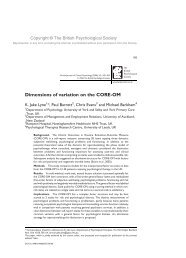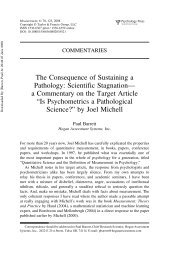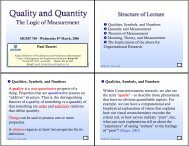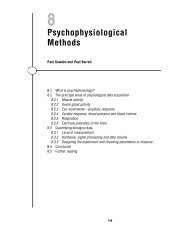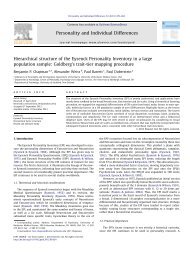Counselling Psychology Review - Paul Barrett
Counselling Psychology Review - Paul Barrett
Counselling Psychology Review - Paul Barrett
You also want an ePaper? Increase the reach of your titles
YUMPU automatically turns print PDFs into web optimized ePapers that Google loves.
Dr Miodrag Popovic, Dr D. Milne & Professor P. <strong>Barrett</strong><br />
Open-ended responses/comments were<br />
classified within the four subscale domains<br />
of the questionnaire and within four types:<br />
positive, negative, inaccessible and constructive<br />
remarks.<br />
Results and discussion<br />
Response rate<br />
Of 65 clients approached to participate in<br />
the study, 61 (94 per cent) completed the<br />
questionnaire at Time 1. (By selecting all<br />
clients of the participating therapists, any<br />
biased sampling on this level has been<br />
avoided.) Forty-five (74 per cent) of the<br />
respondents, i.e. 69 per cent of those<br />
approached, also completed the questionnaire<br />
at Time 2.<br />
A loss of 16 (26 per cent) clients between<br />
Time 1 and Time 2 may be partly explained<br />
by the participants’ cancellations and nonattendances;<br />
similar rates are reported elsewhere<br />
(Shalan & Palmer, 1998). Unknown<br />
differences between respondents and nonrespondents,<br />
i.e. positive sampling biases<br />
due to high drop-out, may interfere with the<br />
interpretation of results but no significant<br />
difference is observed in distributions of the<br />
participants’ gender, problems’ severity and<br />
age at Time 1 and Time 2.<br />
The obtained response rate is high,<br />
bearing in mind that, for just one questionnaire,<br />
response rates are usually about 50 per<br />
cent, ranging from 21 per cent to 85 per cent<br />
(Stallard, 1996). The combination of guaranteed<br />
anonymity and confidentiality, direct<br />
contact, the possibility of clarifying any item<br />
ambiguities as well as the participants’ current<br />
semi-dependent status and wish to please (as<br />
once demonstrated by Trinder, Mitchell,<br />
Newnes & Todd, 1994) are likely to have<br />
contributed to the response rate. Every effort<br />
was made for the instrument to be attractively<br />
set out and no attempt was made to counteract<br />
a possible response set halo effect by<br />
randomisation of the direction of the scale, as<br />
previously suggested (Oppenheim, 1992; Fitzpatrick,<br />
1992); these have made the questionnaire<br />
more user friendly and maximised ease<br />
of completion and the return rate.<br />
Socio-demographic and health information<br />
The majority (70 per cent) of participants<br />
were females (similar to that expected<br />
nationally; e.g. Kellett, Newman & Beail,<br />
1999), with both gender having moderate to<br />
disabling problems (approx. 96 to 98 per<br />
cent) and being aged 16 to 56 (97 to 98 per<br />
cent). Comparing with the general population<br />
in Cumbria (Office for National Statistics,<br />
2000a; 2000b), fewer client-participants<br />
in this study are in employment (77 per<br />
cent) and romantic relationship (80 per<br />
cent). As this sample was one third of all<br />
clients attending the AMH during the study<br />
duration, it is assumed that the client sample<br />
used is representative of the range of score<br />
of the total population of clients of the<br />
Department’s AMH Service.<br />
It has been found that different groups<br />
express different levels of satisfaction (Fitzpatrick,<br />
1992a; William & Wilkinson, 1995);<br />
these findings justify the inclusion of questions<br />
relating to background information<br />
and health status in satisfaction questionnaires.<br />
Qualitative objectives<br />
Acceptability and clarity<br />
Client-volunteers’ involvement in the questionnaire<br />
design, i.e. wording of questions<br />
has been helpful. Their positive reactions to<br />
the questionnaire, a high response rate, no<br />
direct refusals and the absence of reported<br />
discomfort, difficulties and negative reactions<br />
to the questionnaire indicate satisfactory<br />
acceptability and clarity. However,<br />
despite efforts to minimise social desirability<br />
in the information sheet, clients’ wish to<br />
please has perhaps been elevated by the<br />
direct involvement and presence of the therapist<br />
during the completion of the questionnaires.<br />
Face and content validity<br />
As judged by positive reactions and the<br />
substantive agreement between all relevant<br />
parties with regard to relevance, comprehensiveness,<br />
dimensionality and usefulness,<br />
20 <strong>Counselling</strong> <strong>Psychology</strong> <strong>Review</strong>, Vol. 22, No. 2, May 2007



